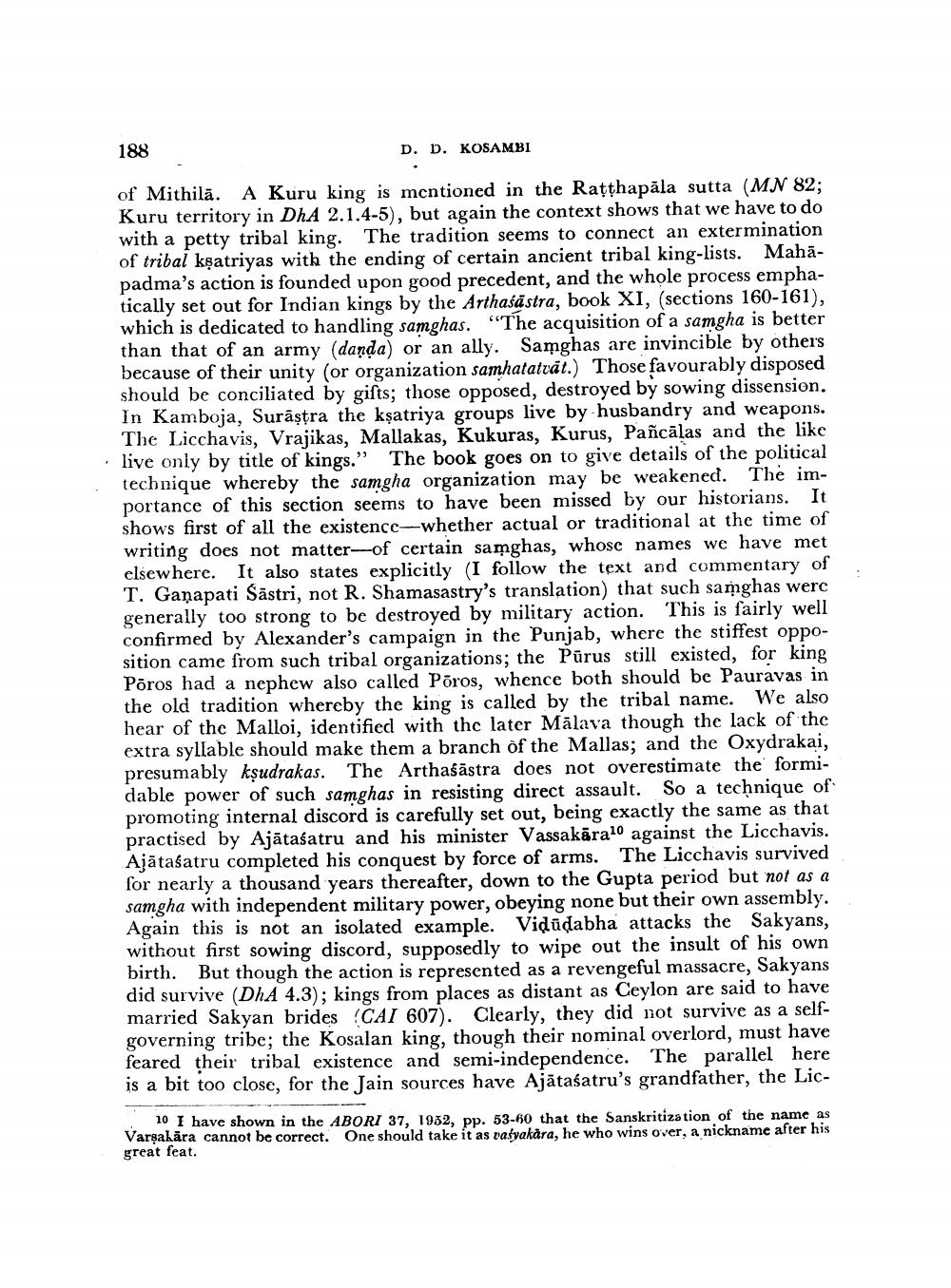Book Title: Ancient Kosala And Mmagadha Author(s): Dharmanand Kosambi Publisher: D D Kosambi View full book textPage 9
________________ 188 D. D. KOSAMBI A Kuru king is mentioned in the Ratthapala sutta (MN 82; Kuru territory in DhA 2.1.4-5), but again the context shows that we have to do with a petty tribal king. The tradition seems to connect an extermination of tribal ksatriyas with the ending of certain ancient tribal king-lists. Mahāpadma's action is founded upon good precedent, and the whole process emphatically set out for Indian kings by the Arthaldstra, book XI, (sections 160-161), which is dedicated to handling samghas. "The acquisition of a samgha is better than that of an army (danda) or an ally. Samghas are invincible by others because of their unity (or organization samhatatcát.) Those favourably disposed should be conciliated by gifts; those opposed, destroyed by sowing dissension. In Kamboja, Surastra the ksatriya groups live by husbandry and weapons. The Licchavis, Vrajikas, Mallakas, Kukuras, Kurus, Pañicālas and the like. live only by title of kings." The book goes on to give details of the political technique whereby the samgha organization may be weakened. The importance of this section seems to have been missed by our historians. It shows first of all the existence-whether actual or traditional at the time of writing does not matter-of certain samghas, whose names we have met elsewhere. It also states explicitly (I follow the text and commentary of T. Ganapati Sastri, not R. Shamasastry's translation) that such samghas were generally too strong to be destroyed by military action. This is fairly well confirmed by Alexander's campaign in the Punjab, where the stiffest opposition came from such tribal organizations; the Pürus still existed, for king Poros had a nephew also called Poros, whence both should be Pauravas in the old tradition whereby the king is called by the tribal name. We also hear of the Malloi, identified with the later Mälava though the lack of the extra syllable should make them a branch of the Mallas; and the Oxydrakai, presumably ksudrakas. The Arthasästra does not overestimate the formidable power of such samghas in resisting direct assault. So a technique of promoting internal discord is carefully set out, being exactly the same as that practised by Ajàtasatru and his minister Vassakärale against the Licchavis. Ajātaŝatru completed his conquest by force of arms. The Licchavis survived for nearly a thousand years thereafter, down to the Gupta period but not as a samgha with independent military power, obeying none but their own assembly. Again this is not an isolated example. Vidadabha attacks the Sakyans, without first sowing discord, supposedly to wipe out the insult of his own birth. But though the action is represented as a revengeful massacre, Sakyans did survive (DhA 4.3); kings from places as distant as Ceylon are said to have married Sakyan brides (CAI 607). Clearly, they did not survive as a selfgoverning tribe; the Kosalan king, though their nominal overlord, must have feared their tribal existence and semi-independence. The parallel here is a bit too close, for the Jain sources have Ajätasatru's grandfather, the Lic 10 I have shown in the ABORI 37, 1952, pp. 53-60 that the Sanskritization of the name as Varsahara cannot be correct. One should take it as rasyakara, he who wins over, a nickname after his great feat.Page Navigation
1 ... 7 8 9 10 11 12 13 14 15 16 17 18 19 20 21 22 23 24 25 26 27 28 29 30 31 32 33 34
